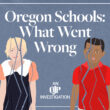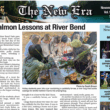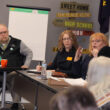By Roberta McKern
For The New Era
When we wonder about how those who settled the Sweet Home area shaped it, The East Linn Museum is a good place to revisit.
For one thing, people made their livings according to at least three different shifts: farming and stock raising, using the land; the timber industry; and the search for gold in the Quartsville area.
Each category can be followed in the museum. We can also see technological evolutions through collections like those of telephones, cameras and even of washing apparatus and machines, wrenches, and car jacks.
But mostly we go for the human equations. Not that technology is not good, but now we can believe it is aimed at swallowing what is human. This gives us the occasional desire to look at the past and the specialness of individual endeavor and community organization, when people drew together to help each other, particularly in the early days of the great emigration of the mid 1850’s.
As an example, we can think of the organizing of the East Linn Museum in 1974. It was a culmination of community action focused on preserving our area’s formative years beginning at the end of the 1840s and continuing into the early 20th century.
The museum hasn’t always clung to pioneer days because the 20th century brought great changes, but the museum’s intent to focus on early days still remains.
Why? We might say because technological shifts have been driving us further and further away from what we imagine was a simpler time although simpler times generally look good because we are not there. Better simpler times, we admit, needed running water and flush toilets, central heating and electricity.
Those the museum has while it showcases the plainer past of chamber pots, wood burning cast iron stoves and the tools it took for farming, logging and mining.
As the museum indicates, simpler times meant a lot of labor but also a sense of community, when people banded together to help each other. As emigrants into an unfamiliar land, early settlers had to build the structures of society often with limited resources.
Even if they wrecked the landscape and overly exploited the natural world, they set the scene for what we know.
And the museum shows we can come to understand the pioneers by what they left behind.
Now and then a visitor will ask “What’s the oldest thing here?” While they pause among the relics, a smart answer is, “the rocks” – an unsatisfactory reply for someone who wants to see “down the Oregon Trail,” qualifying whatever they gaze upon.
True, stone tools and bowls displayed to give recognition to those who once lived here are likely older than pieces of worn tools left by the pioneers. In the mining room, too, are displays of local semi-precious gemstones, agates, petrified wood and jaspers included, which are also old rocks, but not labeled Oregon Trail either.
We do have at least one artifact satisfactorily old that did come west on the Oregon Trail, a spinning wheel labeled “Do Not Touch” because everyone wants to give it a spin. There may well be older pieces that could be labeled ”Oregon Trail”, but they are not so identified.
Often, the small things appear most interesting, like a buttonhook for high-topped shoes which turns into a bottle opener, or a little tourist book of San Francisco that came out not long before the 1906 earthquake. The booklet contains pictures of a Chinese family considered to be rare.
To appreciate the museum, we have to be surprised by the unexpected objects people once found fascinating, such as moustache cups with a little shelf inside below part of the rim to protect a male coffee or tea drinker’s upper lip adornment, especially if it’s shaped like a handlebar with waxed tips curling up.
Or we might imagine the dreams and ambitions a young girl could have attached to a little bottle of a perfume sample or, if she was more competitive, a handful of clay marbles.
Of course, what is important is our willingness to bring curiosity and imagination to what we see, and the East Linn Museum is a good place in which to hone those skills. To a certain extent, we can observe technology grinding forward.
In the 1930s our world underwent a rapid change because the logging industry really took hold, thanks to the coming of the railroad to Sweet Home and up to Dollar Camp on the Calapooia, and the impending second world war.
Once the United States got engulfed in that war, the demand for more timber led to expediency and the development of chain saws and better rigging in the woods.
The museum’s logging collections, including spring boards and 12-foot-long two-man crosssaws, shows this when compared with the collection of chain saws hanging from the rafters in the back room.
In addition, the long cast-iron cook stove from Dollar Camp reflects the effort to get logs out of the Calapooia watershed (as well as the museum’s founders’ desire to keep us in touch with what really happened during a particular time of expansion and turmoil).
Meanwhile, despite an over-reliance on technology for amusement, we can turn some of our leisure time to wandering through the past and be happy life has gotten better – so far better than the Great Depression of the 1930s and world wars in 1914-1918 and 1939-1945, although we stayed out at the beginning of each war.
In the Military Room there are a few survivors from war times, like the World War I bugle and helmet worn by a driver of a horse-drawn ambulance in combat and a poignant box of possessions left behind by a boy who died of an infection in his foot.
What a waste war can be.
For community, we can look to various friendship quilts. One was pieced together at the beginning of World War II by ladies from the Quartzville area. During hard times, the ladies reassured each other and often paid a penny as dues.
Because the stitcher of each block signed the one he or she had done, we can tell who lived in such friendly communities.
We must respect those who settled here and built farms and stores and tended to schools and the mail. Portraits of some of these people look down on visitors who come through the main doors. Dressed in their best, these locals asserted their importance to the early 20th century.
We can go to the Reference Room and learn part of their stories. They are history personified, about some of whom we can say, “Ah, humanity.”
But like all things, their images are only a partial representation of what was in the East Linn area. One advantage to having the museum is that it gives us both the ability and the impetus to learn more of the past, and if we are not always impressed, we can still pay our respects to the human experience still ongoing.
Just a reminder: The museum is in need of volunteers. If the museum is closed on Thursday, Friday or Saturday when we usually have it open, it is likely due to a shortage of volunteers. As a community asset, the museum is worthy of volunteer time and there is plenty of history to enjoy.
If history interests you, or you’d like to build appreciation for our community, the East Linn Museum might be the place for you to spend some time!





